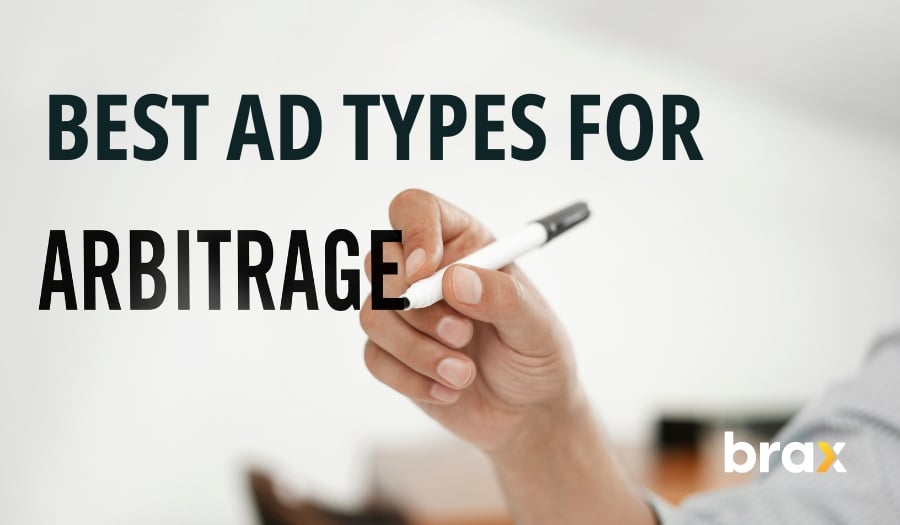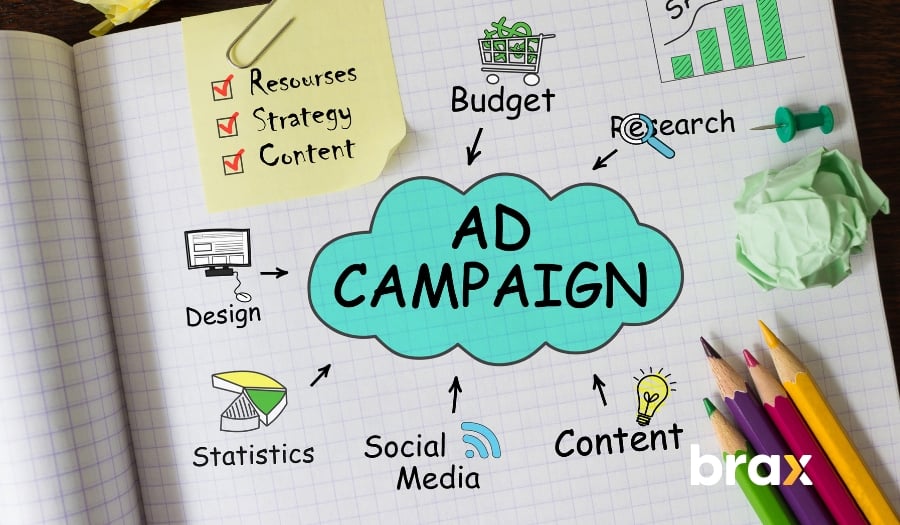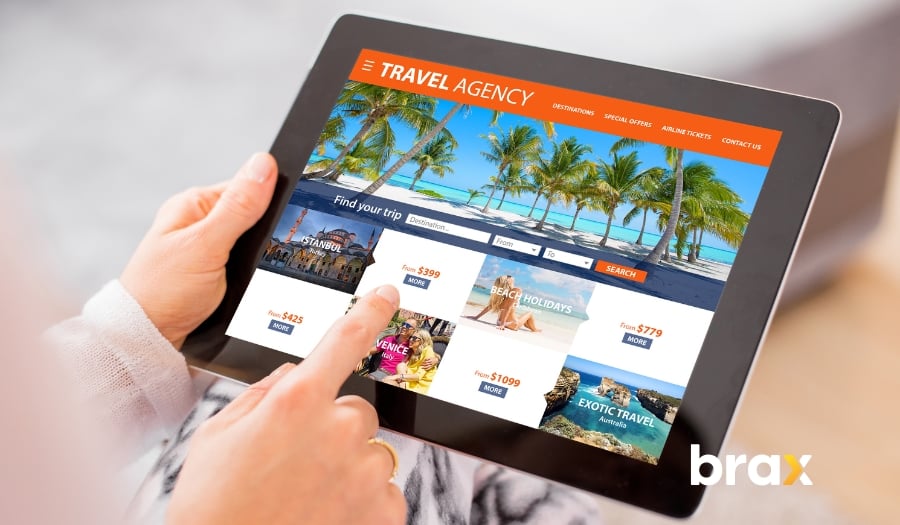Arbitrage business, in its simplest form, is the art of buying low and selling high. It’s like finding a discounted designer outfit in a thrift shop and selling it on a high-end retail platform at a significant markup.
While the arbitrage business model offers substantial profit opportunities, a critical challenge remains — ensuring your content reaches the right audience. To generate significant earnings from ads, your content must also attract a considerable number of viewers.

However, given today's saturated digital landscape, standing out can be particularly challenging. This is where the power of advertising comes into play.
Advertising is the lifeblood of an arbitrage business. Think of it as the loudspeaker that amplifies your bargain-hunting prowess to the world. Without effective advertising, your carefully written and curated content are like hidden gems in a mine, undiscovered and undervalued.
Once you understand and strategically leverage different types of ads, your arbitrage business can reach new heights, similar to that of a diamond once it's dug from the earth and expertly cut and polished.
And that's what we're here for today!
Best Ad Types for Your Arbitrage Business
In the dynamic world of arbitrage businesses, selecting the right advertising format is more than just a strategy — it's a lifeline. While there are numerous advertising formats out there, we'll only be focusing on the best ad types that can not only boost your profits but also keep you in the good graces of your ad arbitrage publishing networks.
As competition intensifies, understanding and utilizing these optimal ad formats could be the defining factor between thriving or merely surviving.
So, buckle up, and let's navigate through the promising landscape of ad types for your arbitrage business.
#1. Native Advertising
Embark on an enticing journey through the land of Native Advertising, a realm where ads blend seamlessly with their surroundings, creating a seamless user experience.
Native Advertising is an online advertising format that harmonizes with its digital environment like a chameleon, adopting the visual and editorial codes of the host site. Unlike traditional advertising, native ads are less intrusive, maintaining the coherence and continuity of the page content.
Cost of Native Ads
There are two common pricing models in this space: Cost Per Click (CPC) and Cost Per Thousand Impressions (CPM).
If you're all about making connections and getting handshakes from potential customers, then the CPC model is your best bet. It's like paying for a dance only when someone accepts your invitation to the floor.
And guess what? The bidding can start as low as $0.0001 per click. This means that even if your budget is as tight as a drum, you can still make some noise.
On the flip side, if you're the kind of person who likes to shout your message from the rooftops, the CPM model is your megaphone. Picture it like buying a billboard on Times Square; you're paying for every set of eyes that might glance your way.
And here's the kicker: you can get started for as little as $0.01 per thousand impressions. However, it's not very useful for search arbitrage sites since you need users to visit your website to get better ad revenue.
But before you sprint off to spend your coins, remember this: the cost can vary. The price tag on a bigger platform like Outbrain may be higher than on lesser-known platforms like Mondiad.
And don't forget about the location. Just like real estate, targeting users in ritzy neighborhoods (highly competitive markets or regions with higher purchasing power) could cost more than aiming for the up-and-comers in less competitive areas.
Read: How Much Do Native Ads Cost
Where to Buy Native Ads
Now, imagine harnessing this unique power for Ad Arbitrage, the crafty art of buying advertisements at bargain prices and reselling them for a profit. Native Advertising, with its unobtrusive presence, high engagement rates, and low costs, provides a cost-effective means to acquire high-quality website traffic.
If you'd like to try it out, consider native ad platforms like giants Taboola and Outbrain or even off-the-beaten options like Adcash.
With well-known providers, you can expect ads to be shown on high-traffic websites such as Business Insider, Fox News, CNN, Daily Mail, ESPN, The Guardian, The Washington Post, and hundreds more of similar caliber. These platforms offer a vast playground for your native ads, reaching millions of users daily and generating significant engagement.
Smaller ad networks work with publishers you likely would never have heard of, which is why normally the publishers are hidden in code. You can only choose the website where your ads appear based on the category or the content.
But while their traffic is nowhere near the same as the top ad networks, you can still expect them to deliver millions of impressions a day at lower prices.
Native Ads Tips for Ad Arbitrage
To successfully navigate the terrain of Native Advertising for Ad Arbitrage, there are key strategies to follow. Here are some:
Strategy Implementation
First things first, you need to understand your audience. It's like going on a first date. You need to know what they like, what they don't like, and what will catch their attention. This can be done by identifying trending topics and crafting relevant, click-worthy content.
Choosing the Right Type of Native Ad
There are different types of native ads, each as unique as a snowflake. Some of these include:
- In-feed ads
- Recommendation widgets
- Branding Video or Native Video Ad
- Native Carousel Ads
- In-article Ads.
- Branded Content or Sponsored Content
- In-app Native Ads
- Promoted Listings or eCommerce Listings
Each type serves a different purpose, so choose wisely based on your target audience and campaign objectives. Have a look at our quick guide on native ad formats to learn more about each of them.
Measuring Performance
Now, onto the next step — measuring performance. It's like being a detective, keeping track of all the clues and piecing them together to solve the case. But instead of clues, you have metrics.
Some of the key metrics to keep an eye on include Click-Through Rate (CTR), Conversion Rate, and Return on Ad Spend (ROAS). These metrics are like the cardinal directions on a compass, guiding you toward your goal.
Tools and Strategies for Improvement
There are numerous tools available that can help you analyze these metrics. You need to constantly analyze your results, tweak your strategies, and test new ideas to keep improving your performance.
Enter Brax — your command center for native advertising.
Brax is a specialized tool engineered to streamline your native advertising endeavors. It's your one-stop shop, merging all your ad activities on a single, user-friendly platform.
With Brax at your disposal, you can bid farewell to the era of toggling between multiple platforms. Instead, you get a unified dashboard that fosters organization and efficiency.
But this platform isn't just about neatness. It’s a powerhouse for analytics. In today's data-centric marketing landscape, actionable insights are the cornerstone of success.
Brax offers real-time performance metrics, arming you with a holistic understanding of your ad performance. This treasure trove of data empowers you to make decisions rooted in evidence, replacing guesswork with strategic planning.

Moreover, Brax is your ally in ad optimization. By pinpointing which ads are pulling in the most traffic and generating maximum revenue, you can channel your resources more effectively.
This not only enhances your return on investment but also turbocharges your operational efficiency.
In a nutshell, think of Brax as a dedicated assistant that manages, analyzes, and optimizes your native ad campaigns. It's a cutting-edge solution crafted to deliver tangible results, steering you confidently through the complex maze of traffic arbitrage.
If you'd like to see Brax in action, why not schedule a demo? It's free, and I guarantee that at the end of it, you'll see how it can help improve your arbitrage business.
For more comprehensive instructions on how to be a native advertising pro, read our Insider Tips for 2023.
Pros and Cons of Native Ads for Arbitrage
As a marketing aficionado, I can assure you that native advertising holds a pivotal role in the ad arbitrage blueprint. This strategy is meticulously crafted to meld with the user experience, often leading to elevated user engagement and impressive click-through rates.
However, every strategy has its peaks and valleys. Let's immerse ourselves in the pros and cons of harnessing native advertising for ad arbitrage.
The Bright Side:
- Superior Engagement Rates: Native ads are chameleons, mimicking the aesthetic and vibe of the surrounding content, making them less intrusive and more engaging to users. This often catapults engagement rates into a higher orbit compared to conventional display ads.
- Impressive Click-Through Rates (CTR): The seamless fusion of native ads often piques the user's curiosity, yielding better CTR. This aligns perfectly with the ad arbitrage strategy, where the goal is to purchase low (per click) traffic and sell high.
- Seamless Integration: Native ads are like an unobtrusive whisper in the ear, providing an enhanced user experience as they blend effortlessly with the site's content. This can foster increased trust and credibility with your audience, turbocharging engagement and conversion rates.
The Flip Side:
- Limited Scalability with Smaller Ad Networks: While native ads can offer higher engagement and CTR, they may stumble when it comes to scalability on smaller ad networks. This roadblock could throttle your ability to reach a larger audience and maximize profits.
- Higher Costs: Native ads can occasionally weigh heavier on the wallet than traditional display ads. This could tip the scales affecting the profitability of your ad arbitrage model if the cost per click overshadows the revenue generated from impressions. To solve this, you must continuously test and tweak as needed.
In the grand scheme of ad arbitrage, the aim is to pocket a profit by buying low-cost traffic and getting higher ad revenue. Native advertising, with its superior engagement and impressive CTR, seems to march in step with this goal.
#2. Display Ads
In the fast-paced digital marketing landscape, display advertising carves out a substantial niche. It entails advertising that employs visually captivating elements such as graphics, images, and videos on an array of publisher sites, including well-known platforms like the Google Display Network or Microsoft Ads.
Unlike their online ad siblings who dress in plain text, display ads prefer to don vibrant clothes of rich media. This unique attribute not only makes them the life of the party but also enhances their aesthetic appeal, making them hard to ignore.
Benefits of Display/Banner Ads
This ad type offers several irresistible benefits for ad arbitrage, namely:
1. Good Targeting
Display ads are like heat-seeking missiles. They allow you to target your audience based on previous websites visited, interests, locations, and more. This precision can lead to highly relevant ads and, consequently, increased engagement rates.
2. Turbocharged Website Traffic
Imagine display ads as a fleet of taxis ferrying people (paid traffic) to your website. By reaching a wider audience across multiple websites and platforms, these ads act as your brand's taxi service, driving a surge in website traffic.
Cost of Display Ads
However, like a fancy dinner at a high-end restaurant, display ads come with a price tag. These ads usually operate on a Cost Per Mile (CPM) or Cost Per Click (CPC) business model.
Prices can swing like a pendulum depending on various factors such as the platform used, the size of the ad, and its placement. For example, an ad displayed on a premium website is like a penthouse suite — it costs more due to its prime location.
There are several platforms where you can purchase these digital billboards, with Google Ads being the popular kid on the block. It offers extensive reach and advanced targeting options.
Alternatively, you can explore programmatic advertising platforms such as BuySellAds, which use AI to automate the buying and selling of ad space — it's like having a personal assistant that will handle your ad space transactions.

Display Ads Tips for Ad Arbitrage
To effectively cash in on display ads for traffic arbitrage, the goal is simple — buy low, sell high. With the right execution, this strategy can significantly elevate your revenue.
Here are some practical tips:
1. Identify Interests and Demographics
It's like fishing — you need to know what bait to use to catch the fish you want. Make sure your ads target users who are most likely to engage with them.
2. Experiment with Ad Placements
Don't be afraid to move the furniture around. Test out different ad placements to determine what garners the best results for your campaign. Does a skyscraper banner work? Is an in-feed display ad better? Do audiences click on the banner in the middle of the content?
3. Monitor Performance
Keep an eagle eye on your campaign's performance and make necessary adjustments based on data.
Pros and Cons of Display Ads for Arbitrage
Lastly, every coin has two sides, and so do display ads in ad arbitrage.
The Bright Side:
- Broad Reach: Display ads can be showcased on numerous sites across the internet, giving them a much wider reach than other ad types — they're like the popular kid at school, everyone knows them, and most website publishers turn to them. So whatever your arbitrage niche may be, you'll surely be able to find a publishing website that's a perfect match.
- Visual Appeal: With their use of rich media, display ads are like a peacock in full display — captivating and hard to ignore.
The Flip Side:
- Ad Blocker Threat: Like all digital ads, display ads face the biggest threat of being blocked.
- Variable Costs: The cost of display ads can vary depending on the platform and ad placement — it's like shopping for clothes; prices fluctuate based on brand and quality.
- Banner Blindness: Banner blindness refers to the tendency of web users to unconsciously ignore banner-like information on websites, an inadvertent result of the overwhelming digital noise. This phenomenon can severely reduce the effectiveness of display ads, as users may overlook them, diminishing their potential impact and the overall success of your ad campaign.
All in all, there's a lot of potential with display ads. Just make sure you watch over your ads carefully to avoid overspending and not seeing a cent of it back.
#3. Social Media Ads
In the rollercoaster ride that is digital marketing, social media advertising has taken the front seat. It's like the cool kid in school that everyone wants to befriend.
And why not? Especially for ad arbitrage businesses, which can use social media advertising to play the field of ad network pricing differences and score some serious profits.
It's a digital marketing strategy where ads are created and spread across social media platforms faster than a juicy piece of gossip. These ads can morph into many forms, including sponsored posts, stories, in-stream videos, and carousel ads.
The main goal? To extend your reach, boost brand visibility, drive web traffic, and ultimately, get conversions. And in the case of arbitrage marketers — higher CPM for ads on their pages.
Benefits of Social Media Advertising in Ad Arbitrage
If social media advertising were a superhero, its superpower would be high engagement. It beats traditional advertising channels hands down, offering a faster and easier way to reach a broad audience.
Plus, it allows for ultra-precise targeting. So instead of shouting your message in a crowded room, you're whispering it directly into the ears of those most likely to be interested.
Social media platforms also play the role of your personal Sherlock Holmes. They provide detailed analytics, allowing you to keep track of ad performance and adjust your strategies like a pro.
This data-driven approach by social media ads is like a treasure map for traffic arbitrage businesses, leading them to the most profitable ad placements.
Cost of Social Media Adverts
Social media advertising offers several pricing models:
- Cost Per Click (CPC): You pay each time someone clicks on your ad. It's like paying for every bite of a delicious cake — totally worth it if your goal is to drive traffic to your website. So this is a check for ad arbitrage.
- Cost Per Impression (CPM): You pay for every 1,000 times your ad is viewed. It's like renting a billboard on the busiest street — perfect for boosting brand awareness.
- Cost Per Action (CPA): You only pay when a user completes a specific action, like filling out a form. It's ideal for conversion-focused campaigns, but not much into arbitrage websites unless you are building an email list for yourself.
Social Media Platforms for Advertising
Social media platforms are like high school cliques, each with its unique vibe. While there are actually many social networks out there, let's just focus on the ones actively offering advertising options:
- Facebook: The jock of social media platforms. It's the biggest platform within the Meta group, having over 2.95 billion monthly active users. It certainly offers unparalleled reach and is best when targeting the middle to the older generation.
- Instagram: The artsy kid. Also owned by Meta, Instagram is perfect for running visually appealing ads. This is best for younger to middle age generations.
- LinkedIn: The nerd. LinkedIn is your go-to platform if your target audience includes professionals or B2B customers.
- Twitter: The gossip queen. Twitter is perfect for timely, topical ads, but remember, the news cycle moves fast here!
- Pinterest: The dreamer. Pinterest users often use the platform for inspiration and planning, making it a good fit for certain niches like home and living, arts and crafts, and similar topics. The market is predominantly women.

Tips on Using Social Media Ads for Ad Arbitrage
When developing social media ads for ad arbitrage, consider the following:
- High-Performing Placements: Use your platform's analytics to find the sweet spots that deliver maximum engagement and conversions.
- Develop Engaging and Persuasive Ad Copy: Just like icing on a cake, your ad copy needs to be enticing. Invest in high-quality visuals and compelling copy to get your audience drooling.
Pros and Cons of Social Media Ads for Ad Arbitrage
Finally, let's not forget every rose has its thorns. Here are some pros and cons of using social media ads for traffic arbitrage:
The Bright Side:
- Wide Reach: Like shouting from a mountaintop with a really large megaphone, you're reaching billions of users worldwide.
- Targeted Advertising: It's like having a GPS for your ads, guiding them to the right audience. Social Ads have the best options when it comes to targeting and laser-pointing the right audience for you.
- Easy to Use: Social media ads are relatively easy to set up and manage. Platforms like Facebook offer automated tools that help you create your own campaigns in a few clicks.
The Flip Side:
- Expensive: The cost of social media ads can add up quickly, and it’s not always easy to predict the results of your campaigns. If you've never tried social media ads before, you can just as easily lose your advertising budget.
- Restrictions: Social media platforms often have strict guidelines on the kind of content they allow. Breaking them can result in ads being pulled or accounts getting banned — definitely not what you want for ad arbitrage.
- Complexity: It's like solving a Rubik's cube. You need a deep understanding of each platform's algorithms, targeting options, and best practices.
- Competition: With so many businesses clamoring for attention, standing out is harder than looking for a diamond on a beach.
But hey, who said life was easy? With careful planning, targeted advertising, and engaging ad content, social media advertising can be revolutionary for your arbitrage business.
Conclusion
Harnessing the power of advertising for traffic arbitrage can be a game-changer for your business. They offer a wide reach, precision targeting, detailed analytics, and a treasure trove of engagement.
However, it's crucial to approach it with a strategic mindset, taking note of the costs, understanding the platforms' algorithms, and adhering to their guidelines to avoid any unwanted setbacks.
If you decide to venture into native ads, consider using Brax as your ad management tool. Our platform offers a streamlined and efficient way to manage multiple native ad campaigns, providing detailed performance data that can aid in enhancing your ad arbitrage strategies.
Try it now and get a 14-day free trial. You won't regret it!
Remember, like any business venture, success in ad arbitrage requires careful planning, constant learning, and timely adaptation. Embrace the dynamics of social media advertising, and you'll have a powerful tool to maximize your ad revenue. Happy arbitrating!

